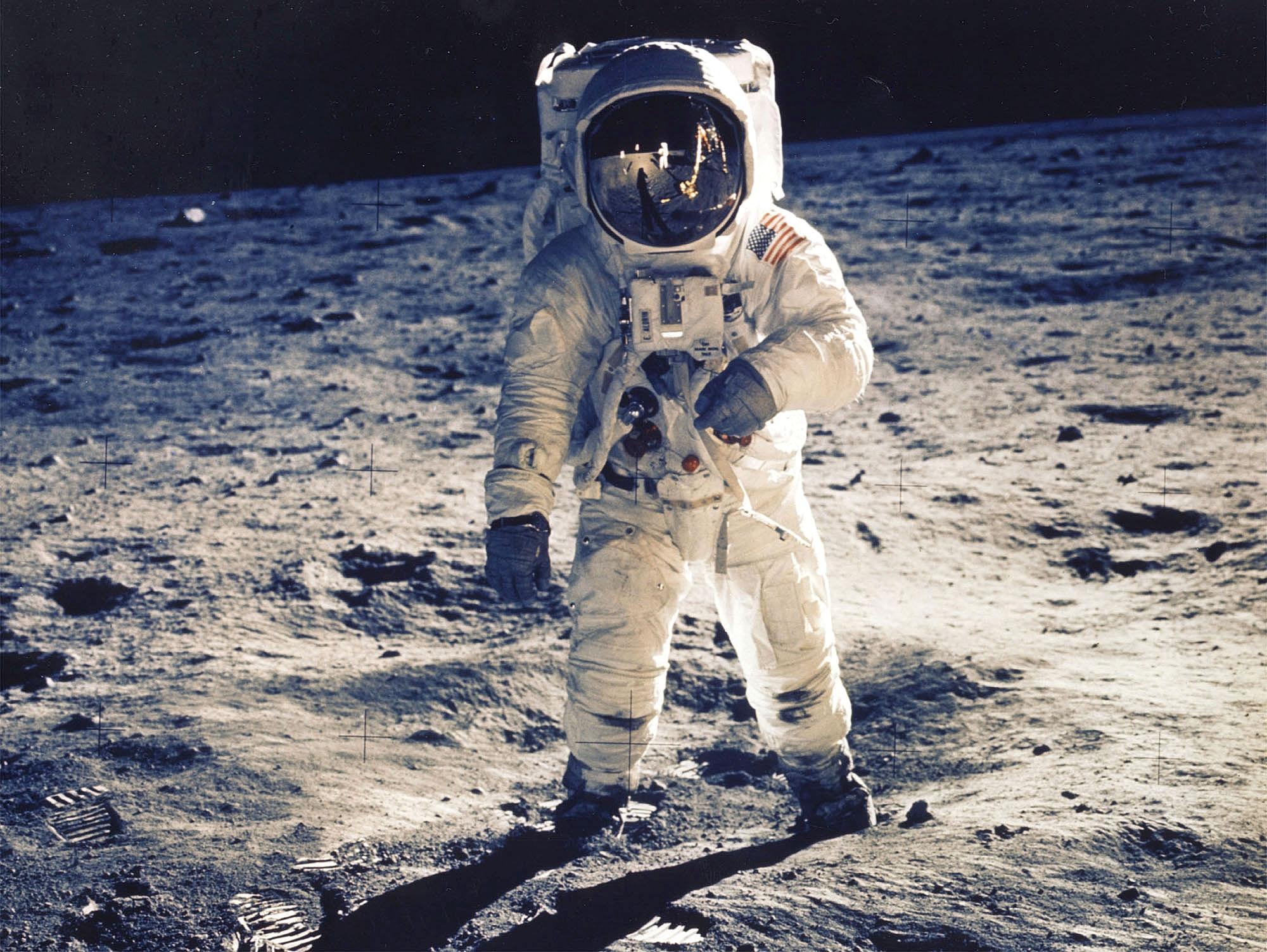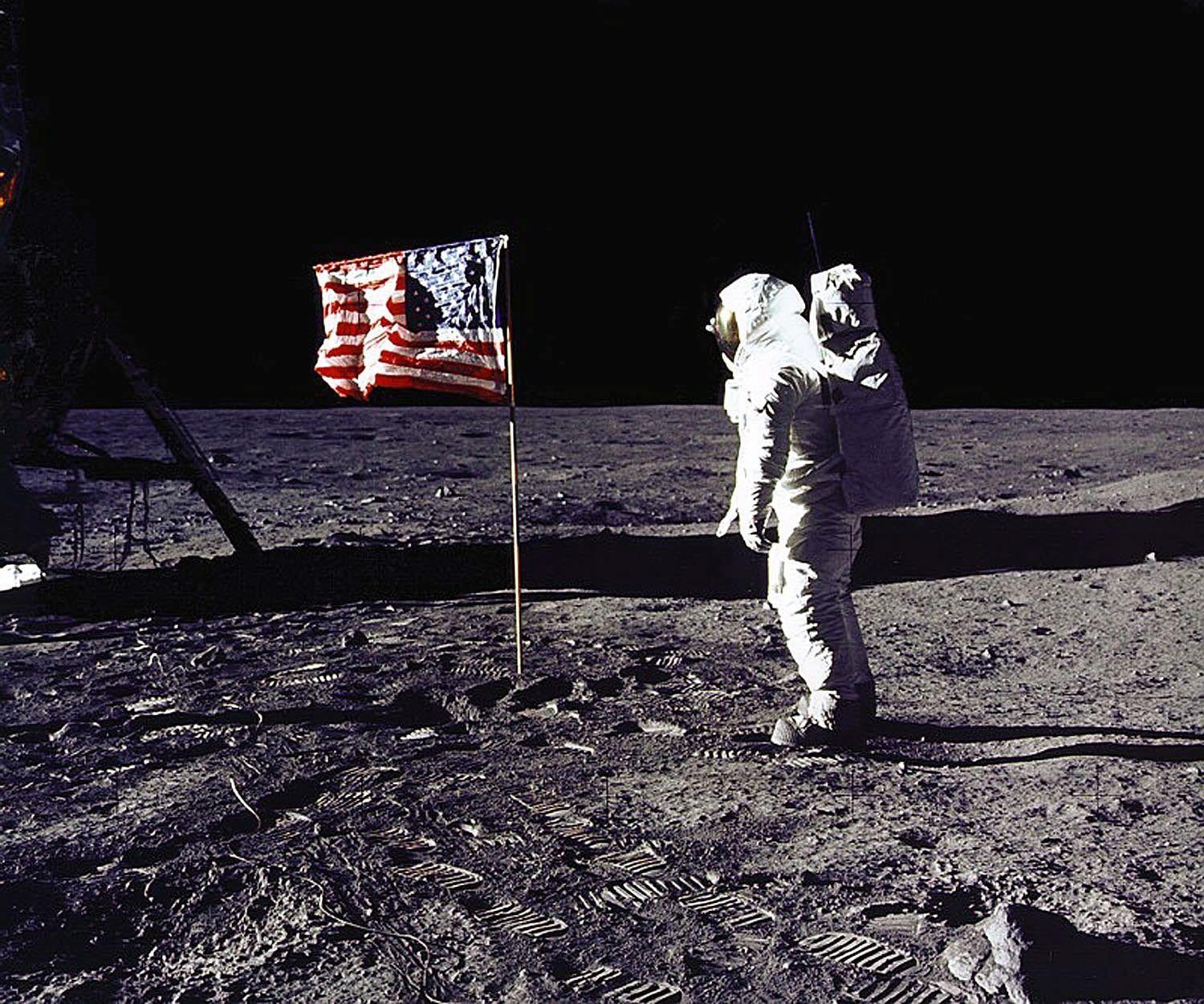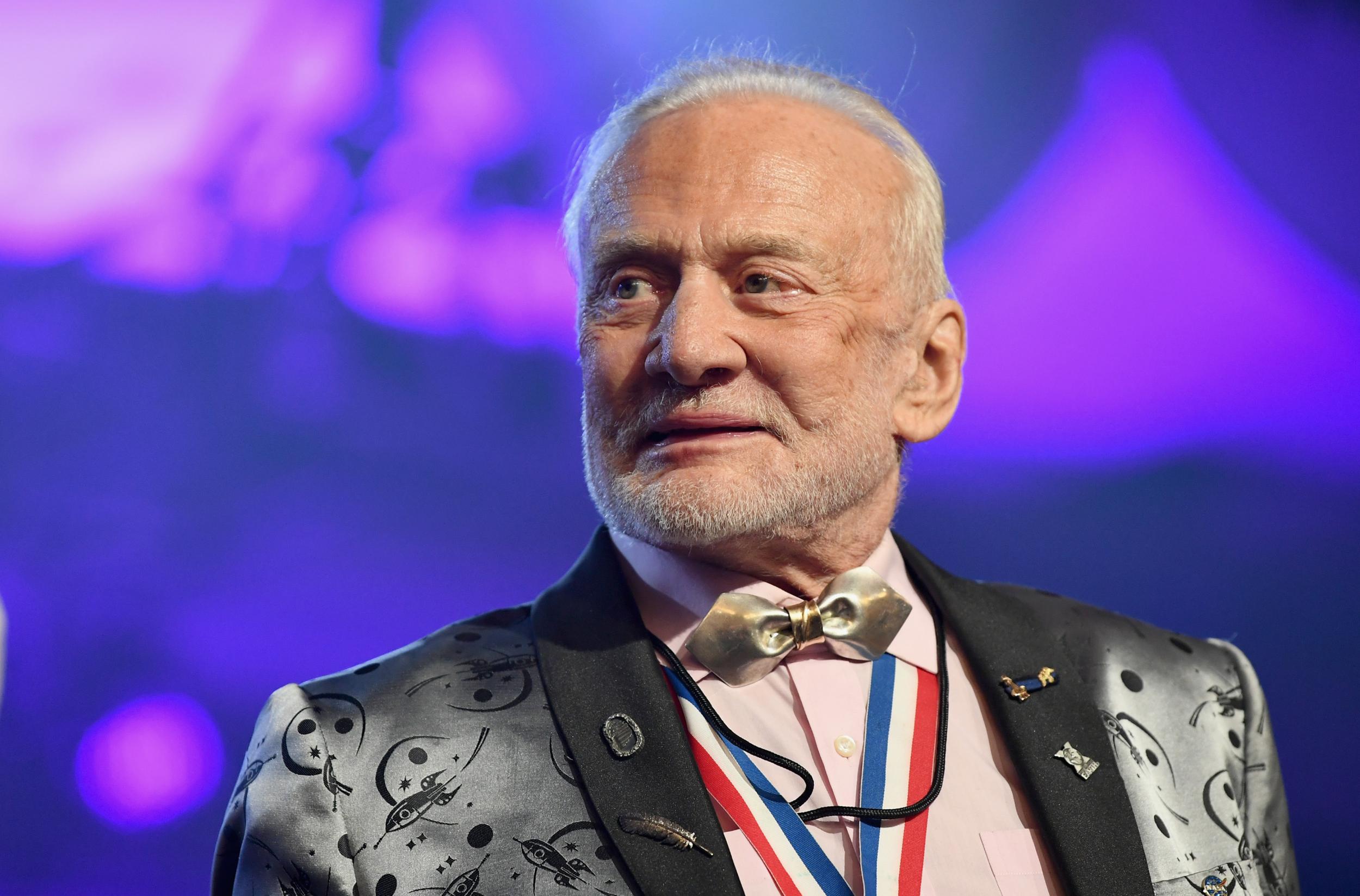The Independent's journalism is supported by our readers. When you purchase through links on our site, we may earn commission.
Moon landing mystery: Did Buzz Aldrin really play Frank Sinatra on the moon?
According to modern legend, the crooner’s classic love song ‘Fly Me to the Moon’ was the first song ever played on the lunar surface – but did it really happen? By Martin Chilton


Quincy Jones was at a party in Sun Valley, Idaho, in 1987, when a stranger, dressed in a white military jacket covered with medals, came up to the music producer and said cryptically: “We worked together before but we’ll talk about it later.” Jones, who did not recognise the man, later told The New York Times magazine that he was nonplussed until a fellow partygoer told him it was Buzz Aldrin, the second man on the moon after Neil Armstrong, who had made his giant leap for mankind.
The Apollo 11 lunar lander touched down at Tranquility Base on 20 July 1969 – when Armstrong uttered the famous words “the Eagle has landed” to Nasa’s Mission Control in Houston – and Buzz Aldrin told Jones what happened next. He said that he reached back and grabbed a cassette of “Fly Me to the Moon”, a song Jones had arranged and conducted for singer Frank Sinatra and jazz bandleader and pianist Count Basie. A modern legend seemed to be confirmed: Sinatra’s song was the first music ever heard on the moon.
Jones told The New York Times in 1990 that he “freaked” at Aldrin’s story. The man who had been known as Buzz since childhood – after his sister Fay Ann’s mispronunciation of the word brother as “Buzzer” – had delighted Jones by confirming what Sinatra had first told him back in the immediate aftermath of the landing. Jones vividly recalled Sinatra, as excited as “a little kid”, ringing him after meeting the successful astronauts in August 1969 to say that Aldrin had played their song in space. Over the years, Jones has repeated the claim many times, including to GQ, NPR and the Associated Press.
Iowa-born Bart Howard composed his famous love song “Fly Me to the Moon” in 1954 and said it took him about 20 minutes to finish. “The song just fell out of me,” recalled Howard, who originally titled it “In Other Words”, after a recurring line of lyrics. An executive at Decca Records suggested re-naming the song “Take Me to the Moon”, before Howard settled on the famous title. Sinatra and Basie recorded the song in 1964, for the album It Might as Well Be Spring. As the space race between America and Russia accelerated in the late 1960s, “Fly Me to the Moon” became part of the zeitgeist.
Fifty years ago, the world rejoiced at the safe return of the three astronauts – Major General Michael Collins had stayed aboard the Apollo 11 Command Service Module while Armstrong and Aldrin went hopping about on the moon – who were welcomed home as heroes on 24 July. Just over three weeks later, the astronauts attended a huge celebration in Houston, Texas. Aldrin’s father, Edwin Eugene Aldrin Sr, was there; his mother was not. The woman who had been born Marion Moon (the eerie coincidence of the name was something Aldrin described as “fate”) had killed herself in May 1968. She had reportedly been anxious and depressed about her son’s imminent fame.
There were 250,000 people on the streets of Houston that August day in 1969. The city held a spectacular ticker-tape parade. So many “Moon Certificates” and fake $100 and $1,000 bills (branded “Unified Space over America”) were thrown at the astronauts that Houston’s streets ended up covered in more than two feet of litter.
Later, there was a special invitation-only barbecue, with Sinatra as master of ceremonies. “You’ve come a long way, baby. Welcome home. We’re proud of y’all,” Sinatra told the astronauts, before launching into a version of “Fly Me to the Moon” that brought the house down. Other star performers included soul singer Dionne Warwick, comedian Flip Wilson, singer Nancy Ames, Buddy Brock and his Orchestra and operatic soprano Marguerite Piazza. The astronauts were pleased that their friend Bill Dana was on the bill. Dana, a comedian whose most famous character was the bumbling, English-mangling José Jiménez, had a routine called The Astronaut, about a man who goes into space and finds it so lonely 240,000 miles away from Earth that he can’t stop weeping. Aldrin, who had described the moon as “a cold, desolate place with no atmosphere and just black sky”, loved the skit.
Understandably, Sinatra was thrilled to have his song indelibly linked with one of the great moments in history. In his 2018 interview with GQ, Jones said that Sinatra obviously understood the commercial value of the link, too. Jones recalled that when the singer known as “Ol’ Blue Eyes” first broke the news, he said: “We got the first music on the moon, man! We’re putting it back in the show!”
Beth O’Leary, a space engineering historian who is co-author of the 2016 book The Final Mission: Preserving Nasa’s Apollo Sites, has no doubts that “Fly Me to the Moon” was given a lunar airing. “It was the first music played by cassette on the moon at Tranquillity Base by Apollo 11 astronaut Buzz Aldrin,” she states unequivocally. Nancy Sinatra said the news that her father had been played on the moon was “one of the great thrills” of her life.
Enjoy unlimited access to 100 million ad-free songs and podcasts with Amazon Music
Sign up now for a 30-day free trial. Terms apply.
ADVERTISEMENT. If you sign up to this service we will earn commission. This revenue helps to fund journalism across The Independent.
Enjoy unlimited access to 100 million ad-free songs and podcasts with Amazon Music
Sign up now for a 30-day free trial. Terms apply.
ADVERTISEMENT. If you sign up to this service we will earn commission. This revenue helps to fund journalism across The Independent.
Music has been interwoven throughout space flight history, from pre-launch songs to shuttle wake-up calls. “Fly Me to the Moon” was certainly included on the cassette Aldrin took to the moon. Ever since the Apollo 7 mission in October 1968, Nasa had equipped every astronaut with a compact Sony TC-50 cassette recorder. Although the primary purpose of the tape was to enable the space travellers to log mission notes verbally, instead of using a pen and paper, they often used the equipment to play their favourite songs. Aldrin’s tape also included “Galveston” by Glen Campbell; “People” by Barbra Streisand; “Three O’Clock in the Morning” by Lou Rawls; “Angel of the Morning” by Bettye Swann; and Peggy Lee’s covers of Sly Stone’s “Everyday People” and Blood, Sweat & Tears’ “Spinning Wheel”.
Armstrong’s choice of music was more offbeat. He took a 1947 album called Music Out of the Moon, by bandleader Les Baxter, which featured Dr Samuel J Hoffman on the Theremin, an electronic instrument that produced the sort of eerie sounds that featured in a lot of science-fiction movies in the 1950s. The scientists at Mission Control in Houston used to groan when they heard Baxter’s album being beamed back from Apollo 11. They were even recorded thanking Armstrong for turning it off.

Sinatra’s music had been to space before its trip on Apollo 11. Lunar Module Pilot Eugene Cernan took “Fly Me to the Moon” on the May 1969 Apollo 10 dress rehearsal mission that orbited the moon. Cernan said the mixed-tape he made with a Boeing employee called Al Bishop included Dean Martin singing “Going Back to Houston” and Acker Bilk’s instrumental “Stranger on the Shore”. Bishop, who liked jazz, preferred Sinatra’s version of “Fly Me to the Moon” to other popular versions by Astrud Gilberto, Doris Day, Dinah Washington and Julie London.
When Nasa’s Mission Report for Apollo 10 was published on 17 June 1969, the space agency confirmed that Sinatra’s version of Howard’s wonderful lyrics (“Fly Me To The Moon/ Let me play among the stars/ Let me see what spring is like/On Jupiter and Mars”) had rung out on the journey to the moon.
Nasa have retained a strong connection with “Fly Me to the Moon”. In September 2008, during a gala to celebrate the space agency’s 50th anniversary, Jones actually presented Armstrong with a framed platinum LP of It Might as Well Be Swing. The music producer also told Armstrong proudly that Jones’s 1969 album Walking in Space, which featured jazz stars Freddie Hubbard, Kai Winding and Ray Brown, had been played in space in April 2008 by astronaut Leland Melvin, during a voyage by Space Shuttle Atlantis.
In July 2009, “Fly Me to the Moon” was performed by Diana Krall at the 40th anniversary commemoration of the Apollo 11 mission, a ceremony held at the Smithsonian Air and Space Museum. Armstrong, Aldrin and Collins were all in attendance. Following Armstrong’s death in August 2012, Krall sang the famous hit again at the astronaut’s memorial service in September at the Washington National Cathedral. Nasa’s headquarters are in Washington and the cathedral has a piece of moon rock embedded in one of its stained-glass windows. In the announcement of memorial, the Cathedral website proclaimed: “Frank Sinatra’s 1964 hit had been played by astronaut Gene Cernan aboard Apollo 10 and by astronaut Buzz Aldrin during the Apollo 11 landing”.
Here comes the problem, though. Aldrin is seemingly not the most reliable witness. He has told different tales at different times. Biographers Anthony Summers and Robbyn Swan asked Aldrin for clarification about “Fly Me to the Moon” being played on the moon while they were conducting research for their 2005 book Sinatra: The Life for Double Day. “The authors contacted Buzz Aldrin and Aldrin responded saying he had not played the song during the flight,” they stated in the appendix.
Seven years later, when he was 82, Aldrin took part in a Q&A at the Empire Hotel in New York, and his answers were recorded on his official website, buzzaldrin.com. “Is it true that the first music heard on the lunar surface was when you played Frank Sinatra’s ‘Fly Me to the Moon’?” he was asked. “No, I don’t remember that,” Aldrin replied. “We could have received it. Sometimes Mission Control played some music as a wake-up call, but I don’t remember what it was! We only had one sleep and one wake-up while we were on the moon.”
Aldrin said he was a fan of Sinatra’s singing and recalled meeting him. “It was just like meeting any other celebrity entertainer,” he said unenthusiastically, adding that he was also a fan of Karen Carpenter. “I like her soft way of projecting her voice. It’s as identifiable as Frank Sinatra’s voice is.”
Aldrin is a complicated man. Jones even described him as “a wild motherf**ker”. The astronaut, who was an elder at Webster Presbyterian church near Houston, took a communion bag and chalice on the moon and admitted in 1970 that he had conducted his own religious service in outer space. “I poured the wine into the chalice our church had given me. In the one-sixth gravity of the moon the wine curled slowly and gracefully up the side of the cup. It was interesting to think that the very first liquid ever poured on the moon, and the first food eaten there, were communion elements,“ he told the Christian magazine Guideposts.

The astronaut found the pressure of coming back to Earth hard to handle. He told Psychology Today in 2001 about his struggles with depression and alcoholism. In recent years, he has been involved in a bitter legal dispute with his children, alleging fraud, conspiracy, and exploitation of the elderly. Despite his troubles, he has shown no desire to be out of the public eye. In 2009, he worked with rapper Snoop Dogg on a song called “The Rocket Experience”; in 2010, he took part in ABC’s reality television show Dancing with the Stars; in 2014 he played himself in the animated 3D movie Fly Me to the Moon.
As the world celebrates the 50th anniversary of Armstrong and Aldrin’s moonwalk, it’s likely that the truth about “Fly Me to the Moon” will never be clear. Was it played on the moon? Was that story just an embellishment, or the result of a faulty memory? Perhaps, as with moon hoax conspiracy theories, we believe what we want to believe.
It has been suggested that if Aldrin had played the song it would have been heard by a controller in Houston. However, Houston lost sound contact with the astronauts for a short spell after they landed on the moon. In the official “Apollo 11 Mission Report”, published by Nasa in November 1969, the Mission Evaluation Team reported that “communications between the command module and the ground were lost during a portion of transposition and docking because the crew failed to switch omnidirectional antennas during the pitch manoeuvre”.
It’s a pleasant thought that Howard’s beautiful love song made it all the way to the moon. “Fly Me to the Moon” has certainly followed Aldrin around back on earth and he said he became fed up with hearing Sinatra’s song at countless ceremonies and functions.
Aldrin even told guests at the 2014 Air and Space Gala, at the Cradle of Aviation Museum, that he was so bored of “Fly Me to the Moon” that he was “interested in composing a new song, entitled “Get Your Ass to Mars!””. You can bet that Sinatra and Basie would have made that song swing, too.
Join our commenting forum
Join thought-provoking conversations, follow other Independent readers and see their replies
Comments
Bookmark popover
Removed from bookmarks